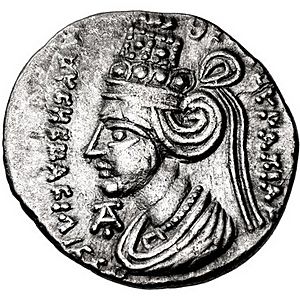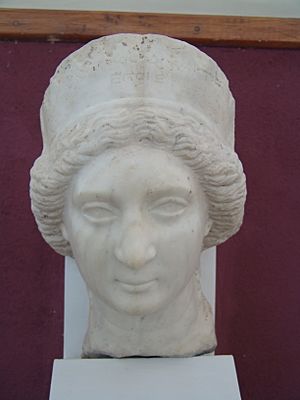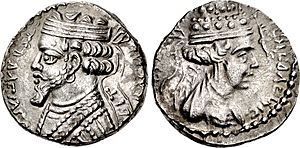Musa of Parthia facts for kids
Quick facts for kids Musa |
|
|---|---|
| Basilissa | |

The portrait of Musa on the reverse of a Parthian drachm, Ecbatana mint
|
|
| Queen of the Parthian Empire | |
| Reign | 2 BC – 4 AD |
| Predecessor | Phraates IV |
| Successor | Orodes III |
| Co-ruler | Phraates V (2 BC – 4 AD) |
| Died | 1st-century AD |
| Spouse | Phraates IV |
| Issue | Phraates V |
Musa (also known as Thea Musa) was a powerful queen who ruled the Parthian Empire from 2 BC to 4 AD. She started her life as an Italian slave girl. The Roman Emperor Augustus (who ruled from 27 BC to 14 AD) gave her as a gift to the Parthian king Phraates IV (who ruled from 37 BC to 2 BC).
Musa quickly became a favorite of King Phraates IV and was made a queen. She gave birth to his son, Phraataces, who later became Phraates V. In 2 BC, Musa took a bold step. She arranged for Phraates IV to be poisoned. After his death, she became the co-ruler of the empire alongside her son, Phraates V. Their time on the throne was short. The Parthian nobles were unhappy and removed them from power. Musa and Phraates V then had to escape to Rome. The nobles then crowned Orodes III as the new king.
Musa is very important in Iranian history. She is one of only three women who ruled as a monarch (a queen in her own right). The other two were the Sasanian sisters Boran and Azarmidokht, who ruled in the 7th century. Other women, like Rinnu, Ifra Hormizd, and Denag, were regents. This means they ruled for their sons, but not as queens themselves.
How Musa Became Queen
Musa was an Italian slave girl. She was given to the Parthian king Phraates IV by the Roman Emperor Augustus. This gift happened around 20 BC. At that time, Rome and Parthia made a treaty. Phraates IV got his kidnapped son back. In return, he gave back Roman military flags (called legionary standards) that had been captured in a battle called Carrhae in 53 BC. He also returned any surviving Roman prisoners of war. The Parthians thought this was a small price to pay to get their prince back.
Some historians, like Emma Strugnell, think Augustus might have sent Musa for a secret reason. Perhaps he hoped she could gather information or influence the Parthian king to help the Romans.
King Phraates IV already had at least four other queens. Their names were Olennieire, Cleopatra, Baseirta, and Bistheibanaps. But Musa quickly became his favorite queen. Around 19 BC, she gave birth to his son, Phraataces (who became Phraates V). Musa wanted to make sure her son would become king. So, around 10 or 9 BC, she convinced Phraates IV to send his four older sons to Rome. This was done to prevent any arguments or fights over who would become king after him.
Musa's Time as Ruler
In 2 BC, Musa took control. She arranged for King Phraates IV to be poisoned. Then, she and her son, Phraates V, became the co-rulers of the Parthian Empire. Later coins of Phraates V are special. They show an image of his mother, Musa, on the back. The writing around her image calls her "heavenly." This was different from older Parthian coins. It showed that Musa was a very important co-ruler. Phraates V also gave her the title basilissa, which means "queen." This title was used for royal women, not just the king's wife, during the Hellenistic era.
A Roman historian from the 1st century, Josephus, wrote that some people claimed Musa married her son. However, there is no other proof for this claim. Also, there is no strong evidence that parents and children married each other in Parthian or earlier Iranian history. Modern historians like Joan M. Bigwood say Josephus's story is likely misleading. They point out it sounds a lot like an old folk tale about an Assyrian queen named Semiramis. Leonardo Gregoratti also doubts Josephus's story. He believes Josephus might have made up this part to make Parthian rulers seem weak.
Musa and Phraates V ruled for a short time. The Parthian nobles became angry. They disliked that Phraates V had recently agreed to Roman control over Armenia. They also disliked that Musa had been an Italian slave. So, they removed both Musa and Phraates V from the throne. They made Orodes III the new king. Phraates V and Musa then fled to Rome, where Emperor Augustus welcomed them.
Possible Pictures of Musa

Some artworks have been thought to be portraits of Musa. These include a gold ring and a gem. However, experts have since questioned if these really show Musa.
In 1939, an archaeologist named Roland de Mecquenem found a bust (a sculpture of a head and shoulders) in Susa. A Greek artist named Antiochus made it. At first, a Belgian archaeologist named Franz Cumont said it was a picture of Musa. Many other scholars agreed. However, the face on the bust does not look much like the face on Musa's coins. The bust wears a crown with castle-like shapes, similar to crowns from the Achaemenid era. But Musa's coins show her wearing a diadem and a jeweled crown with three layers.
The crown with castle-like shapes was often worn by royal family members. But gods and goddesses also wore it. The Greek goddess Tyche is sometimes shown with a similar crown on Parthian coins. Because of this, some scholars now think the bust might be a picture of Tyche, not Musa.
See also
 In Spanish: Musa de Partia para niños
In Spanish: Musa de Partia para niños


